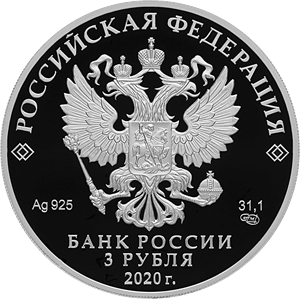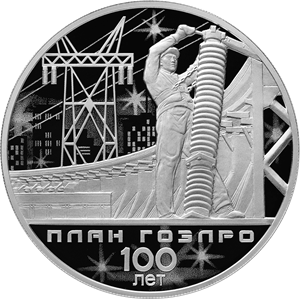100th Anniversary of the GOELRO Plan
Obverse
the mirror field of the disc bears a relief image of the National Coat of Arms of the Russian Federation, over it along the rim there is the semicircular inscription ‘РОССИЙСКАЯ ФЕДЕРАЦИЯ’ (RUSSIAN FEDERATION) framed on both sides by doubled rhombuses, below under the coat of arms there are indications of the precious metal and its fineness on the left and the fine metal content and the mint trade mark on the right, at the bottom in the centre, in three lines, there is an inscription ‘БАНК РОССИИ’ (BANK OF RUSSIA), the denomination of the coin ‘3 РУБЛЯ’ (3 RUBLES), and the year of issue ‘2020 г.’ (2020).
Reverse
the mirror field of the disc bears relief images of an assembly mechanic, a power dam, and power transmission towers against the background of a city view with lighted windows; below there are inscriptions ‘ПЛАН ГОЭЛРО’ (THE GOELRO PLAN) and ‘100 ЛЕТ’ (100 YEARS).
Authors
Designers: E.V. Kramskaya (obverse), A.A. Brynza (reverse).
Sculptors: A.A. Dolgopolova (obverse), A.N. Bessonov (reverse).
Mint: Saint Petersburg Mint (СПМД).
Edge: 300 corrugations.
Discover more
The GOELRO (State Commission for the Electrification of Russia) was established on 21 February 1920 to develop a plan for the electrification of the country after the October Revolution of 1917. The Russian-language abbreviation is often interpreted as the State Plan for the Electrification of Russia, i.e. the plan drafted by the GOELRO, which became the first forward-looking economic development plan adopted and implemented in Russia after the Revolution.
As energy infrastructure construction in Russia expanded, experts became increasingly convinced that the country needed a single national plan that would connect industrial development in the regions with energy infrastructure development, as well as with the electrification of transport and utility services.
To solve the problem of creating a single plan for the national economic recovery and development, which arose after the Revolution, Vladimir Lenin focused on the electrification. In 1920, the GOELRO Commission – the State Plan for the Electrification of Russia – was established. The Commission was chaired by Gleb Krzhizhanovsky – an energy scientist and author of the 'Industrial Electrification Goals' paper. In December 1920, at the extended meeting of the Commission, a plan was developed and approved.
It included a single programme to revive and develop the country and specific industries – primarily the heavy industry – mostly by means of raising productivity as much as possible. The plan strongly emphasised the role of electrification in the development of industry, construction, transport and agriculture. It ordered to use mostly local fuels, including low-value coals, peat, shale, gas and timber.
The so-called 'Programme A' of the GOELRO Plan, which provided for the recovery of the country's ruined energy economy, was completed in 1926. By 1931, the minimum ten-year deadline of the Programme, all energy construction targets had been exceeded. By 1935, which was the end of the fifteen-year term, the Soviet energy industry had reached the global standards and taken the third place in the world after the USA and Germany.
The GOELRO Plan became the very first national plan in Russia and paved the way for the planning system in the USSR. It anticipated the theory, methods and agenda of future five-year plans.
Source: https://minenergo.gov.ru


